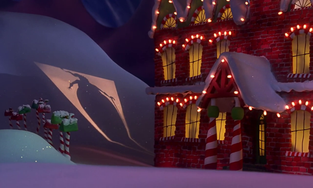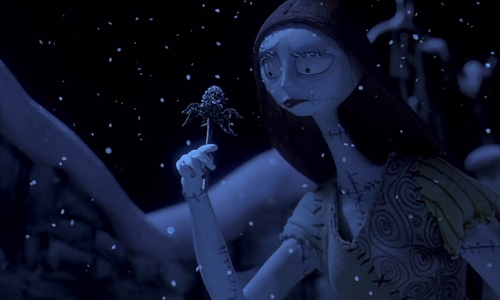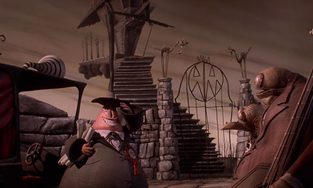
It’s safe to say that Tim Burton pretty much owned the early 90’s. His instantly recognizable style and resoundingly successful run of films gave us all an excuse to let our inner-freak flag fly. I know for certain that Beetlejuice, both Batman films, and Edward Scissorhands were highly influential as far as my outlook and wardrobe went. Let’s just say black became de rigeur as far as my clothes rack went. In effect, Burton’s work helped creepy and weird go mainstream. Much like Alfred Hitchcock or John Carpenter, his name became synonymous with a certain genre or type of film and that’s why you see it above the title. I’ve always found his early success justifiable, well-earned, and utterly baffling.

On paper these films, with the exception of Batman and Batman Returns, shouldn’t have been so successful. Pee-Wee's Big Adventure is delightful and endlessly inventive...and it made money. Beetlejuice is one of the most original, bizarre, and idiosyncratic properties ever released by a major studio...and it made money. Edward Scissorhands is another sweet, deeply personal passion project that was obviously a reward for Batman’s success...and it made money. How?! Just because a movie is great does NOT guarantee box office success, yet he achieved it. Granted, this comment can easily be applied to his outstanding Ed Wood, which didn’t make money but was beloved by critics. It all came crashing down with Mars Attacks!, a film I saw in theatres around Christmastime, a season which absolutely did not fit with that film’s anarchic aesthetic. He bounced back with Sleepy Hollow, but I don’t believe that he’s ever quite approached the brilliance of his early work, despite some good stuff like Big Fish and his remake of Frankenweenie. In the midst of this historic run, he’d lend his story and concept art to one of the most ambitious and jaw-dropping productions of a stop-motion feature in film history. A monumental 3-year project which resulted in a film that holds the rare distinction of being a dual holiday classic. Whether you watch it on Halloween, Christmas, or whenever, The Nightmare Before Christmas (1993) remains an enduring and original piece of work.

I highly recommend checking out the making-of featurettes for Nightmare. Seeing the craftsmanship at work and the way each department works with the other is not only exhilarating but inspiring as well. With the advances in computer-based animation, the hilariously boxy monitors the editors and animators use to render footage seem downright primitive. I was once hired to shoot for a company that I’m not allowed to identify since it was a government agency, but they expected me to edit on a garbage PC that took over 10 minutes just to boot up. I can’t even imagine how long it must have taken for these images to smoothly play out and be manipulated later on.

The work is monotonous and tedious, but the sculptors and designers clearly knew they were working on something special. The limited use of computer effects and the smooth way in which those effects blend with the onscreen stop-motion give the film a timeless feel. In fact, while many films of the 90’s have dated poorly, Nightmare transcends its end-of-the-millennium trappings by being so unique compared to other films of its ilk. Of course, no other film is actually like The Nightmare Before Christmas, but it goes to show that while Disney Studios was in the midst of their legendary animation renaissance, their subsidiary company Touchstone Pictures was the distributor for this creepy crawly little film.

The joke has never not been funny. Poor Henry Selick. This film was a huge opportunity for him and he attacked it with skill and precision, but I can imagine it must’ve been occasionally frustrating when people would incorrectly attribute the more famous Burton as the filmmaker behind the Halloween/Christmas hybrid. Tim Burton did not direct The Nightmare Before Christmas. Yes, his name is above the title. Yes, he came up with the idea, but really, his clout as a bankable filmmaker/producer was what granted the production team the opportunity to explore and experiment in ways no other stop-motion animated film had done. This wasn’t a situation in which a genius like Ray Harryhausen was inserting his awesome monsters and skeletons into existing footage. This was an elaborately constructed world where ten days worth of footage could be ruined by a simple human or mechanical error, resulting in the entire sequence needing to be re-done. It’s mind boggling to think about how frustrating things must’ve gotten.

While clearly deserving, the lone Oscar nomination the film would receive would be for its visual effects, which probably wouldn’t happen today but was very much deserving then. There’s always something in front of the camera and someone had to fabricate it. In featurettes, it’s nice to see Burton hanging around the set and checking out the figures. It has a bit of a “George Lucas looking over creature design concepts for The Phantom Menace” vibe, but far less off-putting. This film was arguably the moment when, for a brief time, Tim Burton indeed approached a Walt Disney-level of name recognition. Still, this was Selick’s baby, and in his words, his job was to “make it look like a Tim Burton film,” which it most definitely does. Burton, busy working on his insanely divisive Batman sequel, would only visit the studio a handful of times, leaving Selick and his team to explore and push the limits of stop-motion animation.

Considering the highly visual nature of the film, the actual plotline can be forgiven for being somewhat thin. Still, as far as fairytales go, it’s a brilliantly simple concept. Each holiday has its own land, including Christmas, Thanksgiving, Valentine’s Day, St. Patrick’s Day, Easter, and of course, Halloween. Jack Skellington (whose vocal work is shared by Oscar-nominee Chris Sarandon, Dog Day Afternoon, The Princess Bride, and composer/lyricist Danny Elfman) lords over Halloweentown but has grown restless with the usual routine: prep for the spooky holiday, scare a few kids, rinse, repeat. His existential issues lead him to a far-off wood where he comes upon a circle of trees with mysterious and colorful doors on them. The Christmas door fascinates him and he soon finds himself inside Christmastown, a bright and colorful land which combines the best of Rankin/Bass and Dr. Seuss.
Although there does appear to be a good heart within Jack’s spidery-legged, giant skeleton frame, he ignorantly and somewhat selfishly decides to snatch up Christmas for his very own and orders Santa to be kidnapped while he delivers his own version of holiday cheer. It’s hilariously appropriate that Jack and the Halloweentown resident’s warped perspective predictably results in some macabre and very inappropriate gifts for young children. A Frankenstein-like woman named Sally (comedy legend Catherine O’Hara, Waiting for Guffman, Home Alone), stitched together from corpses, secretly pines for Jack and knows his plan will be a disaster. Both she and Santa are held prisoner by the ruthless gambler Oogie Boogie (Broadway veteran Ken Page, Ain’t Misbehavin’, Cats) until they’re finally rescued by a reformed Jack and Santa is set free to make everything right in record time because...he’s Santa, goddamnit! Minus the credits, the film barely cracks the 70-minute mark, but give them a break. Very much like Disney’s Snow White and the Seven Dwarves, something of this scale had never been done before.
Director Henry Selick’s slow but steady rise to fame included a stop-off at Disney, where he worked on, what else? The Fox and the Hound, a sweet little film that has become more famous for the number of future filmmakers who worked on it, including Brad Bird, Don Bluth, Ron Clements, John Musker, and a young Tim Burton. After a successful run as a commercial director, his work brought him back to the attention of the now-famous Burton, who’d utilize his similarly unusual predilections to realize his kooky vision. Selick’s post-Nightmare career has been odd, to say the least. James and the Giant Peach is a good film, but is mostly remembered as something of a disappointment compared to Nightmare. Monkeybone was a troubled production only partially saved by the inventive animation, which is to be expected. He’d come roaring back with an uncompromising and unnerving adaptation of Neil Gaiman’s Coraline, for which he’d be nominated for an Oscar.

Beetlejuice and Thinner scribe Michael McDowell would flesh out Burton’s slim story and receive an odd “Adaptation by” credit while Edward Scissorhands co-writer Caroline Thompson received the screenplay credit. Thompson’s script was reportedly extensively re-written by Selick and his team as she was apparently busy with other projects. This isn’t actually surprising considering her impressive number of early 90’s credits that include The Addams Family, The Secret Garden, Homeward Bound, and adapting and directing Black Beauty in 1994. The contributions by these talented individuals can’t be understated, but the most striking and memorable aspect of the production, besides the obvious visuals, is of course Danny Elfman’s score.

While occasionally mocked for some of his goofier scores (Family Guy Star Wars: "Great! Now we gotta do the rest of this thing with Danny Elfman!), Danny Elfman remains one of the best composers in Hollywood. I once saw Forbidden Zone at a midnight screening and I’ve never forgotten it, no matter how hard I’ve tried. Seriously though, it’s bonkers, but as a first foray into feature film composition, it was an audacious start. His next feature assignment would come five years later when he’d provide the wacky score to Burton’s first major success, Pee-Wee's Big Adventure. Thus began one of the greatest director-composer collaborations since Hitchcock and Herrman. If Burton’s imagery represents the childhood of many 80’s and 90’s kids, then Elfman’s evocative music provided the soundtrack. They split briefly around the time of Ed Wood but have since reconciled. Elfman has branched off and created the scores for a myriad of different projects of multiple genres, including Men in Black, Darkman, Freeway, The Frighteners, and Real Steel. There’s a reason Elfman and some of the Nightmare actors have returned for semi-annual live performances of the songs at the Hollywood Bowl. There’s much to like about Tim Burton’s Corpse Bride, but as a spiritual sequel to Nightmare, it pales in comparison, particularly considering the way it appears to resist being a musical despite featuring a few songs by Elfman. Nightmare, on the other hand, is a musical through and through, and a darn fine one as well. Thanks to motion control, there’s a sweep to the musical sequences that make the scenes both whimsical and grandiose.

The opening song may still be the best, “This is Halloween,” a bouncy, catchy tune which deliciously captures the ghoulish fun of Conal Cochran’s favorite holiday. The lyric: “Life’s no fun without a good scare” is a good example of the fun that can be had by being a little more open to experiences and the unknown. Another subtle but clever lyric, “That’s our job but we’re not mean” is very important to establish who these characters are. Though admittedly the presents they later devise for unsuspecting children do appear to be legitimately dangerous, they’re very much about the spirit of Halloween and are by no means a danger to children, despite their grotesque appearance. At a children’s museum I take my daughter to, there’s a panel which plays music, and every Halloween, they switch out their regular songs to play season-appropriate ditties, including Bette Midler’s Hocus Pocus rendition of “I Put a Spell on You” and of course, “This is Halloween.”
Second best is “What’s This?,” a feverishly upbeat song wherein Jack discovers all the wonders of the Christmas holiday. Elfman’s vocal work here brings so much to the character’s astonishment and his lyrics explain a great deal about his confusion and fascination with this (to him) very strange place. Of course, one of the reason’s the internet was invented is to parody songs, so the song “The Fuck?” always brings a smile to my face.
A song which I’d underestimated for quite a while was “Kidnap the Sandy Claws,” a surprisingly tuneful and nasty little ditty sung by Elfman, O’Hara, and public masturbator and Pee Wee himself, Paul Reubens. The lyrics, which are sung by Halloweentown’s most successful trick-or-treaters, are an absolute joy as they twist Jack’s instructions about making Santa comfortable: “Kidnap the Sandy Claws, tie him in a bag. Throw him in the ocean then see if he is sad.”
“Jack’s Lament” works as something of an “I Want” song, but it’s also important as a character piece since we’ve only just met Jack minutes prior being praised for his skills in orchestrating hair-raising Halloween festivities. As the notes bump lower and lower, Elfman’s growling of the lyrics “I...JACK! The pumpkin king!” are fantastic. Some of the songs follow the same motif and essentially don’t really even feel like singular songs, so “Making Christmas,” “Jack’s Obsession,” and best of all “Town Meeting Song” are more triumphs of lyrics. As Jack tries to explain the concept of Christmas to his neighbors, their reactions to these weird objects and customs are adorably graphic: “Is it rotted and covered with gook?” Yeah, that’s how stockings work on the Jeffrey Dahmer Christmas Special. “Sally’s Song” is nice but definitely a track-skipper. That brings us to our villain song.
Ken Page is a big dude and his power and size come through in his vocals. “Oogie Boogie’s Song” is a bluesy, jazz-infused number with fun backup vocals. Nightmare’s energy doesn’t waver, but it can be a risk to introduce a new character so late in a film. Here, it works fine and his appearance, along with his funhouse of various booby traps and contraptions, lend the song a clanking, jangly quality. Exactly what is going on with Oogie is left unknown, although it was later revealed that Sally’s creator, an evil scientist voiced by iconic actor/teacher William Hickey (Oscar nominee Prizzi’s Honor, The Producers), was originally meant to be Oogie in disguise. In the final version, his overall demeanor and aggression toward Jack indicates that he’s something of a loose cannon rebel. When Jack shows up to confront him, it’s not really Oogie’s fault that the trick-or-treaters shoved Santa’s chubby frame through a pipe and into Oogie’s lair. His final form, which turns out to be a mish-mash of worms and bugs, is gleefully nasty.
Speaking of nasty, the film perfectly straddles the line between gruesome and childish. The level of invention is incomparable. Some choice moments include: A trio of vampires who speak and sing in falsetto; the two-faced (get it?) mayor (voiced by Beetlejuice and Demolition Man’s Glenn Shadix), Jack’s first triumphant appearance and later his thin silhouette against a giant moon; Zero, the Rudolph-inspired ghost dog fetching one of Jack’s rib bones; a screaming doorbell and an alarm that sounds like a yowling cat; Sally’s suspicious use of Frog’s Breath in her maker’s soup; the inexplicable but freaky bit where Sally’s flower turns into a Christmas tree before bursting into flame “I had the most terrible vision.” “That’s wonderful!”; a coffin as part of the sleigh; the trailer-worthy sequence where people start freaking out about the presents and the military ends up shooting Jack out of the sky; and Santa being a total badass by not only giving Jack the business but also fixing Christmas in a jiffy. Speaking of which, I’d like to have seen how the elves and Mrs. Claus reacted to his disappearance in Christmastown. Do you think they all killed each other?
This film was made during the Age of Burton. He allowed us to feel cool and express our darker sensibilities. The idea that holidays actually come from a physical place is a fabulous idea and it makes one wistful for a childhood full of holiday fun. The Nightmare Before Christmas, though cultish in nature, will remain long after films made at the same time have faded into nostalgic obscurity.


















































































Comments